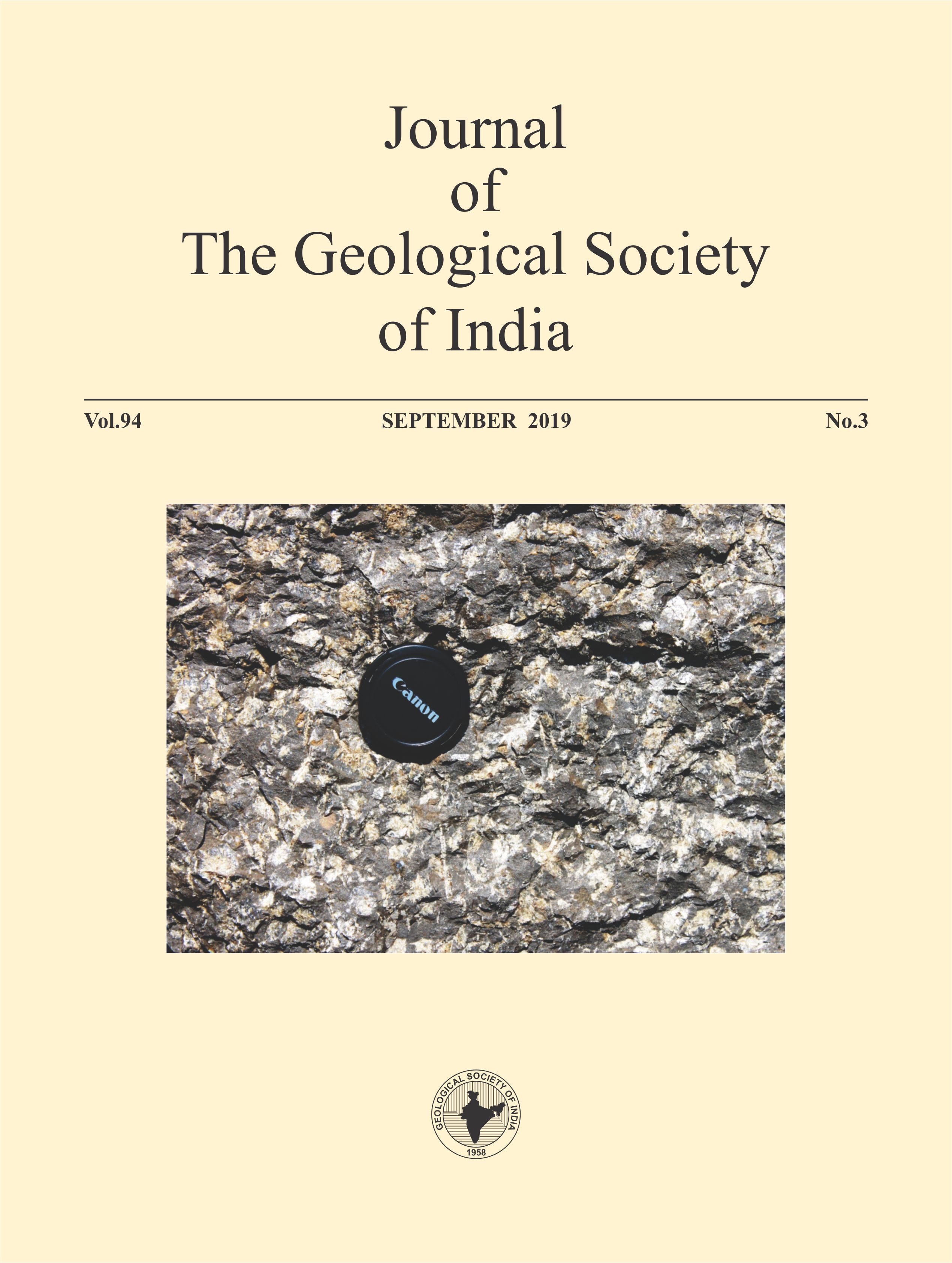Elucidation of Provenance, Palaeoclimate and Tectonic Setting of the Gondwana Sandstones of Arunachal Himalayas: A Petrographic Approach
DOI:
https://doi.org/10.1007/s12594-019-1305-7Keywords:
No Keywords.Abstract
The Permian Gondwana sequence of Arunachal Lesser Himalayas provides an excellent setup to study the provenance and associated tectonics during deposition due to its typical positioning at the margin of the Gondwanic Indian continent. Petrographic character of these Gondwana sandstones exposed in parts of East Siang and West Siang districts of Arunachal Pradesh and inferences on source rocks and tectonic setting are presented in this paper.
The modal analysis of the sandstones reveals that quartz is the dominant detrital framework grain with 58.1-78.30 %, feldspar percentage varies between 0.5 to 4.7 %, the percentage of rock fragments ranges from 1.0 to 12.6 %, mica content varies between 1.3-14.0 %, matrix percentage varies between 6.8-15 % and cement constitutes 3.1-23.5 %. The sandstones are classified as sublithic arenite and quartz arenite. The study suggests quartzose recycled orogen as well as transitional recycled source and indicates towards a low grade metamorphic source for the sediments. It is inferred that these recycled sandstones were originally having its source in the cratonic blocks and sedimentation in this Gondwana basin evolved through multiferous interplay of deformation due to thrust loading, changes in sea level resulting in progressive compaction and a humid climate.
Downloads
Metrics
Issue
Section
Downloads
Published
How to Cite
References
Banerjee, A., Banerjee, D. M. (2010) Modal analysis and geochemistry of two sandstones of the Bhander Group (Late Neoproterozoic) in parts of the Central Indian Vindhyan basin and their bearing on the provenance and tectonics. Jour. Earth Syst. Sci., v.119(6), pp.825-839
Basu, A., Young, S.W., Suttner, L.J., James, W.C. and Mack, G.H. (1975) Re-evaluation of the use of undulatory extinction and polycrysrtallinity in detrital quartz for provenance interpretation. Sediment. Petrol., v.45, pp.873-882.
Boggs, S. Jr. (2009) Petrology of Sedimentary Rocks, second edition, Cambridge University Press, The Edinburgh Building, Cambridge CB2 8RU, UK, 600p.
Boggs, S. Jr. and Krinsley, D. (2006) Application of Cathodoluminescence Imaging to Study of Sedimentary Rocks: Cambridge University Press, Cambridge.
Borah, A.D. and Sarmah, R.K. (2013) Petrography and Clay mineralogy of Dafla and Subansiri Formations (Siwalik Group) of the area between Bhalukpong and Elephant of West Kameng District, Arunachal Pradesh. Jour. Earth Sci., Spl., pp.81-94.
Datta, B. (2005) Provenance, tectonics and palaeoclimate of Proterozoic Chandarpur sandstones, Chattisgarh basin: A petrographic view. Jour. Earth Syst. Sci., v.114(3), pp.227-245.
De Cellers, P.G., Robinson, D.M. and Zandt, G. (2001) Implications of shortening in the Himalayan fold-thrust belt for uplift of the Tibetan Plateau. Tectonics, v.20, pp.487-509.
Dickinson, W.R., Beard, L.S., Brekenridge, G.R., Erjavec, J.L., Ferguson, F.A., Inman, K.F., Knepp, R.P., Lindberg, F.A. and Ryberg, P.T. (1983) Provenance of North American Phanerozoic sandstones in relation to tectonic setting, Geol. Soc. Amer. Bull., v.94, pp.222-235.
Dickinson, W.R. and Suczek, C.A. (1979) Plate tectonics and sandstone compositions. AAPG Bull., v.63, pp.2164-2182.
Dickinson, William R. (1970) Interpreting detrital modes of graywacke and arkose. Sediment. Petrol., v.40, pp.695-707.
Dott, Robert H. Jr. (1964) Wacke, greywacke and matrix- what approach to immature sandstone classification? Sediment. Petrol., v.34, pp.625-632.
Gazzi, P. (1966) Le Arenarie del Flysch Sopracretaceo dell'Appennino Modenese: Correlazioni con il Flysch di Monghidoro, Mineralogic. Petrografica Acta, v.12, pp.69-97.
GSI (2010) Geology and Mineral Resources of Arunachal Pradesh. Geol. Surv. India, Misc Publ., 30 (IV I), 54p.
Ingersoll, R.V., Bullard, T.D., Ford, R.L., Grim, J.P., Pickle, J.D. and Sares, S.W. (1984) The effect of grain size on detrital modes: A test of the Gazzi- Dickinson point counting method. Sediment. Petrol., v.54, pp.103-116.
Jalal, P. and Ghosh, S.K. (2012) Provenance of the Late Neogene Siwalik sandstone, Kumaun Himalayan Foreland Basin: Constraints from the metamorphic rank and index of detrital rock fragments. Jour. Earth Syst. Sci., v.121(3), pp.781-792.
Mahanta, B.N. (2015) Structures and tectono-sedimentation history of the Lower Gondwana and Dafla (Siwalik) sandstones along Main Boundary Thrust Zones in parts of West and East Siang districts, Arunachal Pradesh, Unpubld. Ph.D. thesis, Dibrugarh University, 334p.
Mahanta, Bashab. N., Syngai, B.R., Sarmah, R.K., Goswami, T.K., Guha, S.K. and Kumar, A. (2017) Major oxide studies of Lower Gondwana coals, West Siang District, Arunachal Pradesh, India: analysis of palaeo environment and depositional milieu. Indian Jour. Geosci., v.71(2), pp.395-404.
Pettijohn, F.J. (1984) Sedimentary rocks. 3rd Edition. CBS Publ. and Distributors, Delhi, pp.213-219, pp.571-587, pp.261-314.
Pettijohn, F.J., Potter, P.E. and Siever, R. (1972) Sand and Sandstone. SpringerVerlag, Berlin, pp.566-577.
Phukon, S., Hazarika, S. and Sarmah, R.K. (2010) Study of Petrography and dispersed organic matter of Disang-Barail Group of rocks in DeomaliHukanjuri area, Tirap District, Arunachal Prdaesh, India. Jour. Indian Assoc. Sedim., v.29(1), pp.37-49.
Prakash, A.P, Singh, T. and Suresh, C.S. (1988) Occurrence of faunal coal balls in Gondwana sediments (Permian) of Arunachal Pradesh, India. Internat. Jour. Coal Geol., v.9, pp.305-314.
Stampfi, G.M. and Borel, G.D. (2002) A plate tectonic model for the Paleozoic and Mesozoic constrained by dynamic plate boundaries and restored synthetic oceanic isochrones, Earth. Planet. Sci. Lett., v.196, pp.17-33.
Suttner, L.J., Basu, A. and Mack, G.H. (1981) Climate and the origin of quartz arenites. Sediment. Petrol., v.51, pp.1235-1246.
Tortosa, A., Palomares, M. and Arribas, J. (1991) Quartz grain types in Holocene deposits from the Spanish Central System: some problems in provenance analysis; In: A. C. Morton, S. P. Todd, and P. D. W. Haughton (Eds.), Developments in Sedimentary Provenance Studies. Geol. Soc. London, Spec. Publ., no.57, pp.47-54.

 Bashab N. Mahanta
Bashab N. Mahanta






